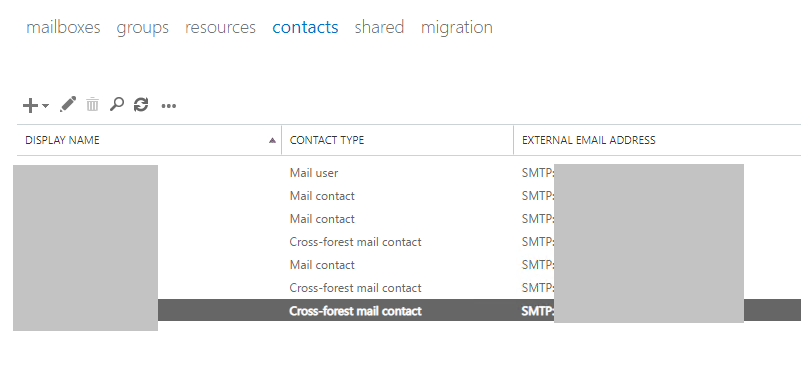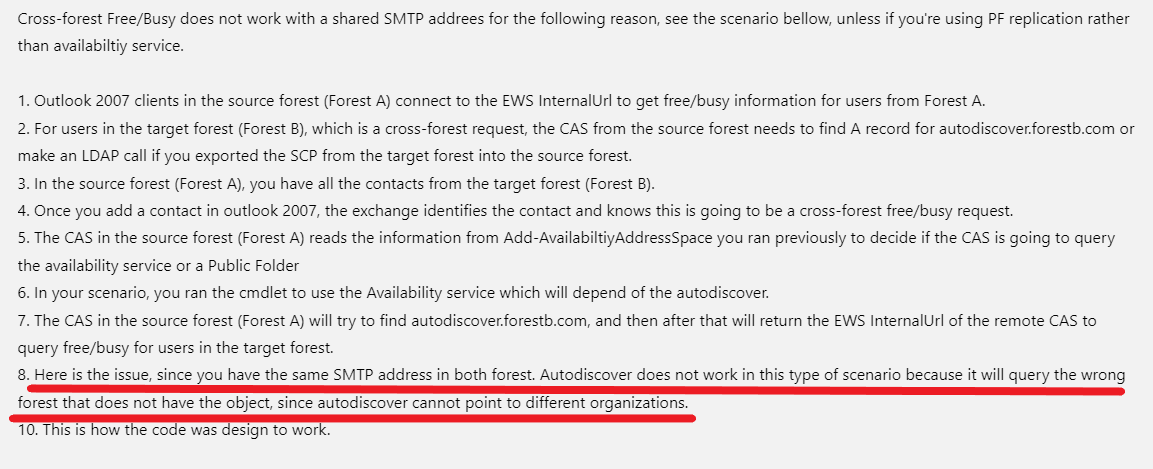Finally got a event LOG: Migtest3 is the account in source (in target is a contact)
Log Name: Application
Source: MSExchange Availability
Date: 3/1/2022 10:15:42 PM
Event ID: 4001
Task Category: Availability Service
Level: Error
Keywords: Classic
User: N/A
Computer: NEXEX16A.NexfinityOne.local
Description:
Process Microsoft.Exchange.InfoWorker.Common.Delayed1[System.String]: <migtest3>SMTP:migtest3@source.local failed in application Free/Busy. Exception returned is Microsoft.Exchange.InfoWorker.Common.Availability.AutoDiscoverFailedException: Autodiscover failed for email address migtest3@source.local with error Microsoft.Exchange.InfoWorker.Common.Availability.AutoDiscoverFailedException: The underlying connection was closed: An unexpected error occurred on a send.. The request information is Discovery URL : https://mail.nexfinityonedev.com/autodiscover/autodiscover.xml, EmailAddress : <migtest3>SMTP:migtest3@source.local. ---> System.Net.WebException: The underlying connection was closed: An unexpected error occurred on a send. ---> System.IO.IOException: Unable to read data from the transport connection: An existing connection was forcibly closed by the remote host. ---> System.Net.Sockets.SocketException: An existing connection was forcibly closed by the remote host at System.Net.Sockets.NetworkStream.Read(Byte[] buffer, Int32 offset, Int32 size) --- End of inner exception stack trace --- at System.Net.Sockets.NetworkStream.Read(Byte[] buffer, Int32 offset, Int32 size) at System.Net.FixedSizeReader.ReadPacket(Byte[] buffer, Int32 offset, Int32 count) at System.Net.Security.SslState.StartReceiveBlob(Byte[] buffer, AsyncProtocolRequest asyncRequest) at System.Net.Security.SslState.CheckCompletionBeforeNextReceive(ProtocolToken message, AsyncProtocolRequest asyncRequest) at System.Net.Security.SslState.ForceAuthentication(Boolean receiveFirst, Byte[] buffer, AsyncProtocolRequest asyncRequest) at System.Net.Security.SslState.ProcessAuthentication(LazyAsyncResult lazyResult) at System.Threading.ExecutionContext.RunInternal(ExecutionContext executionContext, ContextCallback callback, Object state, Boolean preserveSyncCtx) at System.Threading.ExecutionContext.Run(ExecutionContext executionContext, ContextCallback callback, Object state, Boolean preserveSyncCtx) at System.Threading.ExecutionContext.Run(ExecutionContext executionContext, ContextCallback callback, Object state) at System.Net.TlsStream.ProcessAuthentication(LazyAsyncResult result) at System.Net.TlsStream.Write(Byte[] buffer, Int32 offset, Int32 size) at System.Net.PooledStream.Write(Byte[] buffer, Int32 offset, Int32 size) at System.Net.ConnectStream.WriteHeaders(Boolean async) --- End of inner exception stack trace --- at System.Net.HttpWebRequest.GetRequestStream(TransportContext& context) at System.Net.HttpWebRequest.GetRequestStream() at Microsoft.Exchange.InfoWorker.Common.Availability.AutoDiscoverRequest.BeginInvoke() --- End of inner exception stack trace --- . Name of the server where exception originated: NEXEX16A. LID: 56716. ---> Microsoft.Exchange.InfoWorker.Common.Availability.AutoDiscoverFailedException: The underlying connection was closed: An unexpected error occurred on a send.. The request information is Discovery URL : https://mail.nexfinityonedev.com/autodiscover/autodiscover.xml, EmailAddress : <migtest3>SMTP:migtest3@source.local. ---> System.Net.WebException: The underlying connection was closed: An unexpected error occurred on a send. ---> System.IO.IOException: Unable to read data from the transport connection: An existing connection was forcibly closed by the remote host. ---> System.Net.Sockets.SocketException: An existing connection was forcibly closed by the remote host at System.Net.Sockets.NetworkStream.Read(Byte[] buffer, Int32 offset, Int32 size) --- End of inner exception stack trace --- at System.Net.Sockets.NetworkStream.Read(Byte[] buffer, Int32 offset, Int32 size) at System.Net.FixedSizeReader.ReadPacket(Byte[] buffer, Int32 offset, Int32 count) at System.Net.Security.SslState.StartReceiveBlob(Byte[] buffer, AsyncProtocolRequest asyncRequest) at System.Net.Security.SslState.CheckCompletionBeforeNextReceive(ProtocolToken message, AsyncProtocolRequest asyncRequest) at System.Net.Security.SslState.ForceAuthentication(Boolean receiveFirst, Byte[] buffer, AsyncProtocolRequest asyncRequest) at System.Net.Security.SslState.ProcessAuthentication(LazyAsyncResult lazyResult) at System.Threading.ExecutionContext.RunInternal(ExecutionContext executionContext, ContextCallback callback, Object state, Boolean preserveSyncCtx) at System.Threading.ExecutionContext.Run(ExecutionContext executionContext, ContextCallback callback, Object state, Boolean preserveSyncCtx) at System.Threading.ExecutionContext.Run(ExecutionContext executionContext, ContextCallback callback, Object state) at System.Net.TlsStream.ProcessAuthentication(LazyAsyncResult result) at System.Net.TlsStream.Write(Byte[] buffer, Int32 offset, Int32 size) at System.Net.PooledStream.Write(Byte[] buffer, Int32 offset, Int32 size) at System.Net.ConnectStream.WriteHeaders(Boolean async) --- End of inner exception stack trace --- at System.Net.HttpWebRequest.GetRequestStream(TransportContext& context) at System.Net.HttpWebRequest.GetRequestStream() at Microsoft.Exchange.InfoWorker.Common.Availability.AutoDiscoverRequest.BeginInvoke() --- End of inner exception stack trace --- --- End of inner exception stack trace --- . Name of the server where exception originated: NEXEX16A. LID: 56716. This event may occur when the Free/Busy application cannot discover a corresponding application in the remote forest. Event Xml: <Event xmlns="http://schemas.microsoft.com/win/2004/08/events/event"> <System> <Provider Name="MSExchange Availability" /> <EventID Qualifiers="49156">4001</EventID> <Level>2</Level> <Task>4</Task> <Keywords>0x80000000000000</Keywords> <TimeCreated SystemTime="2022-03-02T06:15:42.204397400Z" /> <EventRecordID>7313461</EventRecordID> <Channel>Application</Channel> <Computer>NEXEX16A.NexfinityOne.local</Computer> <Security /> </System> <EventData> <Data>Microsoft.Exchange.InfoWorker.Common.Delayed1[System.String]</Data>
<Data><migtest3>SMTP:migtest3@Source Technology .local</Data>
<Data>Free/Busy</Data>
<Data>Microsoft.Exchange.InfoWorker.Common.Availability.AutoDiscoverFailedException: Autodiscover failed for email address migtest3@Source Technology .local with error Microsoft.Exchange.InfoWorker.Common.Availability.AutoDiscoverFailedException: The underlying connection was closed: An unexpected error occurred on a send.. The request information is Discovery URL : https://mail.nexfinityonedev.com/autodiscover/autodiscover.xml, EmailAddress : <migtest3>SMTP:migtest3@Source Technology .local. ---> System.Net.WebException: The underlying connection was closed: An unexpected error occurred on a send. ---> System.IO.IOException: Unable to read data from the transport connection: An existing connection was forcibly closed by the remote host. ---> System.Net.Sockets.SocketException: An existing connection was forcibly closed by the remote host
at System.Net.Sockets.NetworkStream.Read(Byte[] buffer, Int32 offset, Int32 size)
--- End of inner exception stack trace ---
at System.Net.Sockets.NetworkStream.Read(Byte[] buffer, Int32 offset, Int32 size)
at System.Net.FixedSizeReader.ReadPacket(Byte[] buffer, Int32 offset, Int32 count)
at System.Net.Security.SslState.StartReceiveBlob(Byte[] buffer, AsyncProtocolRequest asyncRequest)
at System.Net.Security.SslState.CheckCompletionBeforeNextReceive(ProtocolToken message, AsyncProtocolRequest asyncRequest)
at System.Net.Security.SslState.ForceAuthentication(Boolean receiveFirst, Byte[] buffer, AsyncProtocolRequest asyncRequest)
at System.Net.Security.SslState.ProcessAuthentication(LazyAsyncResult lazyResult)
at System.Threading.ExecutionContext.RunInternal(ExecutionContext executionContext, ContextCallback callback, Object state, Boolean preserveSyncCtx)
at System.Threading.ExecutionContext.Run(ExecutionContext executionContext, ContextCallback callback, Object state, Boolean preserveSyncCtx)
at System.Threading.ExecutionContext.Run(ExecutionContext executionContext, ContextCallback callback, Object state)
at System.Net.TlsStream.ProcessAuthentication(LazyAsyncResult result)
at System.Net.TlsStream.Write(Byte[] buffer, Int32 offset, Int32 size)
at System.Net.PooledStream.Write(Byte[] buffer, Int32 offset, Int32 size)
at System.Net.ConnectStream.WriteHeaders(Boolean async)
--- End of inner exception stack trace ---
at System.Net.HttpWebRequest.GetRequestStream(TransportContext& context)
at System.Net.HttpWebRequest.GetRequestStream()
at Microsoft.Exchange.InfoWorker.Common.Availability.AutoDiscoverRequest.BeginInvoke()
--- End of inner exception stack trace ---
. Name of the server where exception originated: NEXEX16A. LID: 56716. ---> Microsoft.Exchange.InfoWorker.Common.Availability.AutoDiscoverFailedException: The underlying connection was closed: An unexpected error occurred on a send.. The request information is Discovery URL : https://mail.nexfinityonedev.com/autodiscover/autodiscover.xml, EmailAddress : <migtest3>SMTP:migtest3@Source Technology .local. ---> System.Net.WebException: The underlying connection was closed: An unexpected error occurred on a send. ---> System.IO.IOException: Unable to read data from the transport connection: An existing connection was forcibly closed by the remote host. ---> System.Net.Sockets.SocketException: An existing connection was forcibly closed by the remote host
at System.Net.Sockets.NetworkStream.Read(Byte[] buffer, Int32 offset, Int32 size)
--- End of inner exception stack trace ---
at System.Net.Sockets.NetworkStream.Read(Byte[] buffer, Int32 offset, Int32 size)
at System.Net.FixedSizeReader.ReadPacket(Byte[] buffer, Int32 offset, Int32 count)
at System.Net.Security.SslState.StartReceiveBlob(Byte[] buffer, AsyncProtocolRequest asyncRequest)
at System.Net.Security.SslState.CheckCompletionBeforeNextReceive(ProtocolToken message, AsyncProtocolRequest asyncRequest)
at System.Net.Security.SslState.ForceAuthentication(Boolean receiveFirst, Byte[] buffer, AsyncProtocolRequest asyncRequest)
at System.Net.Security.SslState.ProcessAuthentication(LazyAsyncResult lazyResult)
at System.Threading.ExecutionContext.RunInternal(ExecutionContext executionContext, ContextCallback callback, Object state, Boolean preserveSyncCtx)
at System.Threading.ExecutionContext.Run(ExecutionContext executionContext, ContextCallback callback, Object state, Boolean preserveSyncCtx)
at System.Threading.ExecutionContext.Run(ExecutionContext executionContext, ContextCallback callback, Object state)
at System.Net.TlsStream.ProcessAuthentication(LazyAsyncResult result)
at System.Net.TlsStream.Write(Byte[] buffer, Int32 offset, Int32 size)
at System.Net.PooledStream.Write(Byte[] buffer, Int32 offset, Int32 size)
at System.Net.ConnectStream.WriteHeaders(Boolean async)
--- End of inner exception stack trace ---
at System.Net.HttpWebRequest.GetRequestStream(TransportContext& context)
at System.Net.HttpWebRequest.GetRequestStream()
at Microsoft.Exchange.InfoWorker.Common.Availability.AutoDiscoverRequest.BeginInvoke()
--- End of inner exception stack trace ---
--- End of inner exception stack trace ---
. Name of the server where exception originated: NEXEX16A. LID: 56716</Data>
</EventData>
</Event>

